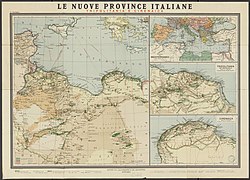Libyan resistance movement
This article has multiple issues. Please help improve it or discuss these issues on the talk page. (Learn how and when to remove these template messages)
|
| Libyan War Of Indenpendence | |||||||
|---|---|---|---|---|---|---|---|
| |||||||
| Belligerents | |||||||
|
Senussi | |||||||
| Commanders and leaders | |||||||
|
|
| ||||||
| Casualties and losses | |||||||
| Unknown |
40,000[1]-70,000 dead[2] (battles, deportation, starvation etc.). | ||||||
| History of Libya | ||||||||||||||||||||||||||||||||||||||
|---|---|---|---|---|---|---|---|---|---|---|---|---|---|---|---|---|---|---|---|---|---|---|---|---|---|---|---|---|---|---|---|---|---|---|---|---|---|---|
 | ||||||||||||||||||||||||||||||||||||||
|
||||||||||||||||||||||||||||||||||||||
|
| ||||||||||||||||||||||||||||||||||||||
The Libyan resistance movement was the rebel force opposing the Italian Empire during its Pacification of Libya between 1923 and 1943.
History[edit]
First years[edit]
The Libyan resistance, associated with the Senussi Order, was initially led by Omar Mukhtar (Arabic عمر المختار ‘Umar Al-Mukhtār, 1862–1931), who was from the tribe of Mnifa. The First Italo-Senussi War had two main active phases: the Italo-Turkish War (1911–12), when Italy invaded Libya, and the Senussi Campaign (1915–17), part of World War I, in which Italian and British forces fought the Ottoman and German-supported Senussi. The Libyans were eventually defeated. After a period of relative peace, the Second Italo-Senussi War broke out in 1923 and lasted until 1932.
Second Italo-Libyan War (1923–1932)[edit]
Later King Idris and his Senussi tribe in the provinces of Cyrenaica and Tripolitania started to become opposed to the Italian colonization after 1929, when Italy changed its political promises of moderate "protectorate" to the Senussi (done in 1911) and—because of Benito Mussolini—started to take complete colonial control of Libya.
Resistance During World War 2[edit]
Resistance was crushed by General Rodolfo Graziani in the 1930s and the country was again controlled by the Italians with the help of Arab fascists, to the point that many Libyan colonial troops fought on the side of Italy between 1940 and 1943: two divisions of Libyan colonial troops were created in the late 1930s and 30,000 native Libyans fought for Italy during World War II. While the Tripolitanian Nobles in Egypt established a corp of themselves that fought along side Libyan Arab Force, this included of many Tripolitanian Tribes[4][5][6]
See also[edit]
References[edit]
- ^ Mohamed Fekini and the Fight to Free Libya - Angelo Del Boca,Antony Shugaar [1]
- ^ A Historical Companion to Postcolonial Literatures - Prem Poddar,Rajeev Shridhar Patke,Lars Jensen [2]
- ^ John L. Wright, Libya, a Modern History, Johns Hopkins University Press, p. 42.
- ^ John, Ronald Bruce St (2015-05-15). Libya: Continuity and Change. Routledge. ISBN 978-1-135-03654-6.
- ^ Peters, Emrys L. (1990). The Bedouin of Cyrenaica: Studies in Personal and Corporate Power. Cambridge University Press. ISBN 978-0-521-38561-9.
- ^ Pollard, Tony; Banks, Iain (2008). Scorched Earth: Studies in the Archaeology of Conflict. BRILL. ISBN 978-90-04-16448-2.

